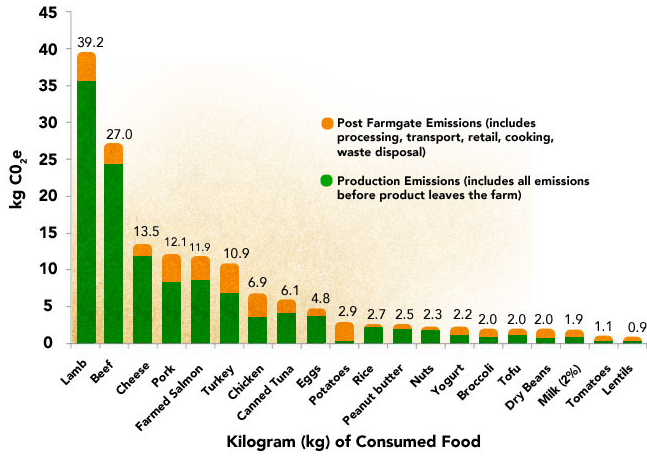For dinner, I chose to make a stir fry with a combination of vegetables as well as ground beef and rice. While it is likely that many of the vegetables I used came from a large distance, thus using alot of transportation energy, the main part of this meal I want to look at is meat consumption.
Richard Manning discusses meat consumption in the article, “The Oil We Eat“. In terms of simple energy flow, he suggests that it is more efficient to eat lower down in the food chain. As you move up the food chain, only 10% of the energy is transferred per each step. So, for instance, when a cow eats a plant and then you eat the cow, you are only obtaining 10% of the energy from the plant. For secondary predators, you are obtaining another ten times less the amount of energy. This is not so bad as long as the cow or other animal is grass-fed and local. However, according to Manning, roughly 78% of the cattle is the U.S. comes from feed lots. Meaning that they are being fed the dreaded corn and wheat products that I discussed in my previous posts. Shockingly, 80% of the grain produced in the U.S. goes to livestock! This seems to be extremely inefficient to me. When I am consuming meat, not only I am I wasting energy by eating higher up the food chain but I am also fuelling the industrial corn crop market. In this article Manning writes, “It takes thirty-five calories of fossil fuel to make a calorie of beef this way; sixty-eight to make one calorie of pork”. I was definitely shocked by such high numbers!
Here is an interesting graph I found displaying the amount of Carbon Dioxide Produced during and after the animal or produce leaves the farm (Source: http://www.easterbrook.ca/steve/?p=2585)
Essentially, although all these products do involve some carbon emission, the major ones to avoid are beef and lamb. I think this visual representation is very powerful because it shows just how much energy goes into producing just 1 kg of these meat products.
Although emissions would greatly be reduced if everyone were to avoid meat products, I don’t think this is likely to happen any time soon. However, it is important to note that consumers have a choice in where they buy their meats from. Although it is more expensive, it is probably worth the price to buy local and grass-fed animal products. Perhaps if more people were aware that beef requires a whopping 35 calories of fossil fuels per calorie of meat, they would rethink the frequency of their meat consumption. I wouldn’t consider myself a huge meat eater but I will definitely consider these statistics when I am purchasing my meat products.
Tags: No Comments



0 responses so far ↓
There are no comments yet...Kick things off by filling out the form below.